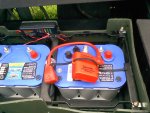kastein
Member
- 495
- 26
- 18
- Location
- Southbridge MA
I think you may be confused, dmetalmiki. If there is a disconnect anywhere, no current is flowing, though voltage may be present.
If you put a disconnect on either side of the battery, right at the battery, you will have no real danger. The issue that arises in a 24 volt or 24/12 volt hybrid system is that if you use a positive disconnect on just the 24 volt (positive of second battery) you will still have the potential for a fault or short anywhere on the 12 volt circuit! But if you disconnect the ground, only faults between the 12 and 24 volt positive circuits or possibly a fault on the 12 volt circuit can cause you trouble. Ideally, all but one circuit (i.e. ground and 12 volt, or 12 volt and 24 volt, or even ground and 24 volt) leading to the battery would be disconnected when the shutoff is active. Or even all 3, but that is not necessary.
You can view voltage as being the same as pressure in a water pipe, and current as flow. Resistance is about the same as a pressure regulator or metering orifice; inductance would be the resistance to change in flow, effectively mass flow (i.e. what causes water hammer.) Capacitance is the same as a storage tank. In this case you would have effectively a pump that increases pressure by say 24psi, it is fine if you disconnect and cap either its inlet or its outlet because it will either have nowhere to push the water to, or nowhere to pull it from.
If you put a disconnect on either side of the battery, right at the battery, you will have no real danger. The issue that arises in a 24 volt or 24/12 volt hybrid system is that if you use a positive disconnect on just the 24 volt (positive of second battery) you will still have the potential for a fault or short anywhere on the 12 volt circuit! But if you disconnect the ground, only faults between the 12 and 24 volt positive circuits or possibly a fault on the 12 volt circuit can cause you trouble. Ideally, all but one circuit (i.e. ground and 12 volt, or 12 volt and 24 volt, or even ground and 24 volt) leading to the battery would be disconnected when the shutoff is active. Or even all 3, but that is not necessary.
You can view voltage as being the same as pressure in a water pipe, and current as flow. Resistance is about the same as a pressure regulator or metering orifice; inductance would be the resistance to change in flow, effectively mass flow (i.e. what causes water hammer.) Capacitance is the same as a storage tank. In this case you would have effectively a pump that increases pressure by say 24psi, it is fine if you disconnect and cap either its inlet or its outlet because it will either have nowhere to push the water to, or nowhere to pull it from.




